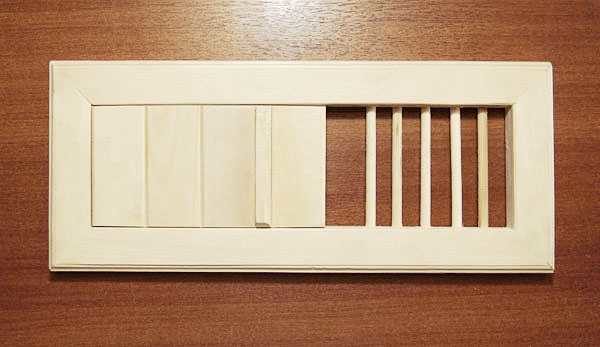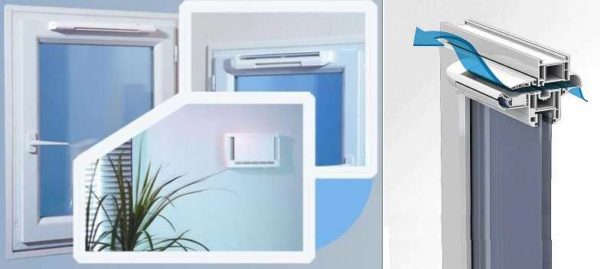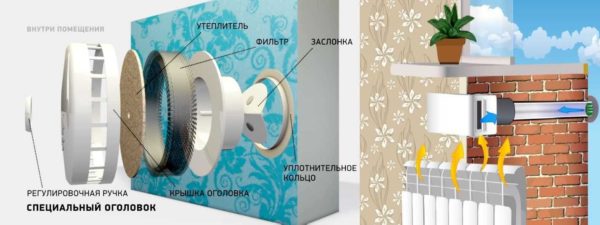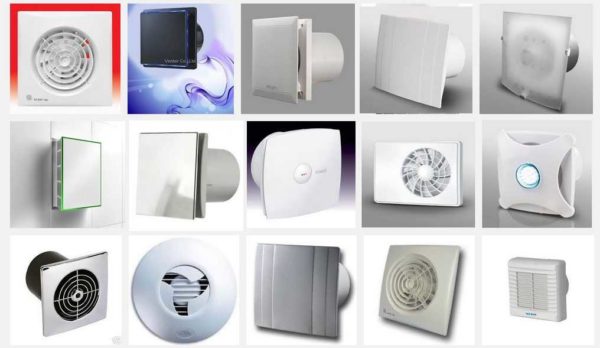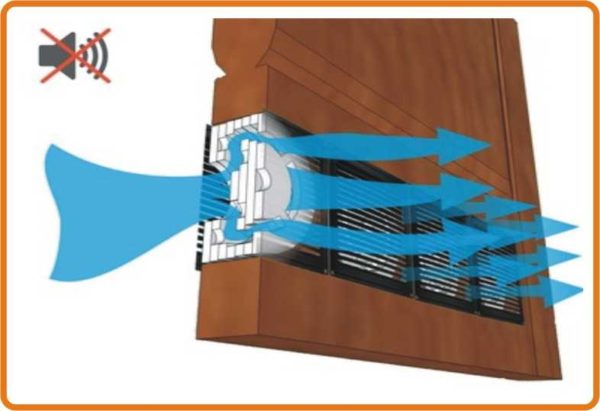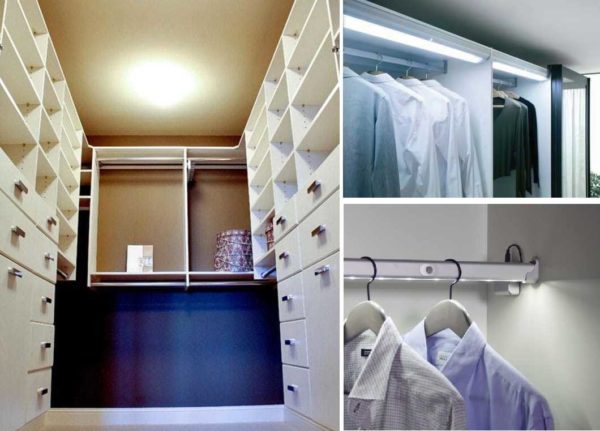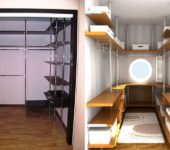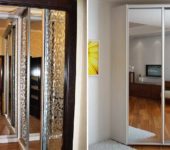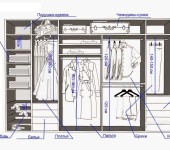How to make ventilation and lighting in the dressing room
In order for things to be stored in the dressing room under normal conditions, so that problems with odors do not arise, good ventilation is needed with dampness. You can hardly do without it. Dressing room ventilation is not the most complicated system, but you also need to know how to arrange it.
The content of the article
Why ventilation is needed and its types
It is imperative to organize good air exchange in the storage areas of things and shoes. On clothes and shoes, particles of skin remain, skin secretions remain, dust accumulates. All this is an excellent environment for the development of microorganisms. Therefore, good ventilation in the dressing room is a prerequisite for maintaining the normal state of things and the absence of a musty smell.
In dressing rooms, as in any other room, ventilation can be natural or forced. Natural ventilation works through physical processes - cold air enters from below, heats up and rises up. Therefore, if you make an intake hole at the bottom, and an exhaust hole on top, air will move at a certain speed.
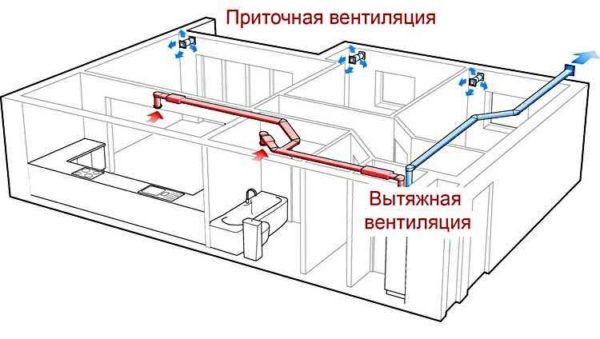
The principle of organizing ventilation of a house or apartment. Dressing room ventilation is part of this system
If ventilation ducts run near the dressing room, it makes sense to branch off to the exhaust outlet. This will solve many problems.
But the natural ventilation of the dressing room can not always provide a sufficient rate of air exchange. To increase it, fans are installed. They can be installed in both supply and exhaust openings. Most often, a forced draft is installed, and the air flow occurs naturally through ventilation gaps or openings. This allows you to spend not too much money, but to ensure a normal indoor atmosphere.
How to make ventilation in a dressing room without windows
Basically, dressing rooms are arranged in small rooms without windows. In this case, there is no reason to hope for air flow through the slots. We need to make holes. The inflow can be ensured through:
- gap between the bottom edge of the door and the floor;
- special door design for dressing rooms (with slots or inserted ventilation grilles);
- holes in the walls, which are located at a height of no more than 20-30 cm from the floor (you can lower it, just above the baseboards);
- technological gaps that were left during the construction of partitions;
- in private houses - through a ventilation hole in the floor (from the lower floor or from the basement, if there is normal humidity).
The sizes of the inlets depend on the volume of the room and the speed of movement of air masses. According to the standards in dressing rooms for storing things, it is necessary to ensure a single exchange of air. For example, if your dressing room has dimensions of 1.5 * 2.0 * 2.8 (width, length, height), then its volume (found by multiplying all the numbers) is 8.4 cubic meters. For an hour, to maintain a normal atmosphere, it is necessary to "pump" 8.4 cubic meters of air. So ventilation of the dressing room will prevent the appearance of foreign odors.
If ventilation is working normally in the apartment, for these purposes it is enough to make an inlet 100 * 100 mm in size. Section - round, square, rectangular - no difference. The main thing is that its area remains the same or more. In general, this parameter is counted or found from the table. But the tables show much larger volumes.
But the ventilation of the dressing room will work normally provided there is an exhaust duct.It could be a similar lattice in the wall. It should be located on the opposite wall from the inlet, closer to the ceiling. Moreover, it is necessary to strive to spread these holes as far as possible - so that the air flow covers as large an area as possible.
If the inlet is made in the door, and the doors are in the middle of the width of the room, then it is worth installing two exhaust grilles - on the right and on the left, stepping back 15-25 cm from the corners.
Where should the exhaust vents go? In the best case, in the ventilation duct. A possible option is to go outside, if one or more walls of the dressing room face the street. In this case, it is possible to bring the supply duct outside, and the exhaust duct into the ventilation or any of the adjoining rooms.
If there are windows
If there is a window in the dressing room, there will be less problems with supply ventilation. If the windows are leaking, natural inflow is usually sufficient. But if they stand plastic windows, it is possible to provide access to fresh air only through ventilation. In this case, it is ideal if there is a micro-ventilation function. By providing a small flow of air over time, a normal atmosphere can be maintained.
If plastic windows have only standard modes, just below the windowsill, on the side of the window or anywhere else on the wall, you can build in valves for air flow from the street. These valves are usually adjustable and can pass air at different speeds.
Depending on the manufacturer, the interior can be round (as shown on the left) or rectangular (shown on the right). Their structure is approximately the same. - filter, insulation, external and internal grilles. A very handy thing not only for supply ventilation of the dressing room, but also for all other rooms, the walls of which face the street.
Do I need a fan
As already mentioned, the natural ventilation of the dressing room does not always provide sufficient air velocity and a musty smell still appears. This usually happens in the summer, when it is too hot outside and the natural air movement is minimal or even the draft overturns (air masses move in the opposite direction). In such cases, fans are installed on the exhaust openings. Their capacity is selected depending on the volume, but as a rule, the very low-power ones are sufficient - 10-50 cubic meters / hour. In this case, the main selection criterion is noiseless operation. After all, many dressing rooms open into bedrooms or other living spaces.
Many people are afraid of installing fans - they have to work almost around the clock. In general, it is not necessary. It is quite enough if it turns on for 15-20-30 minutes every hour. This mode is provided by timers, controllers and other similar devices. All that is required is to select the operating mode and set the appropriate settings.
Yes, these are additional costs, but the forced ventilation of the dressing room works constantly and does not depend on the vagaries of the weather.
To ensure silence
If ordinary grilles are installed on both opposite walls in the dressing room, noise will penetrate through them. Clothing and space will muffle them somewhat, but some sounds will be heard. If that prospect doesn't scare you, great. But if you want silence, special bypass grates or valves are placed in the holes.
They almost do not interfere with the passage of air, but they do not let light and noise through. These grilles are not cheap, but there is another way to make sure that the ventilation of the dressing room is effective and at the same time does not let sounds through.
Lighting in the dressing room
Dressing room is not for you closet... This is a room that you can enter naked and leave fully clothed. Having a large number of shelves, drawers and cabinets requires good lighting. Indeed, only in bright light can you see everything you need without stress and evaluate the compatibility of the selected clothes in the mirror.
For normal lighting in the dressing room, multi-zone lighting is usually done. Some of the luminaires are located on the ceiling. If the ceiling is suspended, recessed luminaires with a large dispersion angle will do. If the ceiling is ordinary - bleached or painted, ceiling lamps or chandeliers of small height are selected. Convenient in this case are models with swivel shades - beams of light can be directed where required.
It is also desirable to highlight the mirror. In this area, you can use sconces or tubular lights. The same - long and thin - can be placed above the pipes, on which the hangers are located, above the large shelves. In general, there are a lot of lamps. So that they do not greatly affect the payment for electricity, it is best to take LED ones. These can be ribbons, cut pieces, lamps, lamps with a standard or small base. The form doesn't matter. It is important that they "pull" very little electricity, have a long life and almost never get warm.
Another way to save money is to think over the lighting system at the planning stage of the dressing room, breaking the lamps into groups and putting them on the switches separately. Whichever group is needed, you include that.
If you don't like looking for switches / switches, you can install motion detectors. They will turn on lighting when there is movement. It is also quite convenient and economical. But in this case it is necessary to set a more substantial delay for turning off the light. Otherwise, you will freeze in front of a mirror, for example, and the light will go out.

